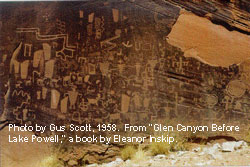Overview of the Glen Canyon Dam and the Colorado River
 The Colorado River is the most dammed river in the United States. In fact, it no longer flows into the sea anymore - it simply peters out in a desert plain in Northern Mexico, except in very wet years, when it does reach the Gulf of California. It is dammed every few hundred miles or so; these dams create hydropower, store water for agriculture, store water for Western and Southwestern cities’ consumption, provide a large recreation area for water sports enthusiasts, and allow for uncurbed urban sprawl in the West.
The Colorado River is the most dammed river in the United States. In fact, it no longer flows into the sea anymore - it simply peters out in a desert plain in Northern Mexico, except in very wet years, when it does reach the Gulf of California. It is dammed every few hundred miles or so; these dams create hydropower, store water for agriculture, store water for Western and Southwestern cities’ consumption, provide a large recreation area for water sports enthusiasts, and allow for uncurbed urban sprawl in the West.
Glen Canyon Dam
Glen Canyon Dam is one such dam on the Colorado River. Completed in 1963, this dam created the second-largest artificial lake (Lake Powell) in the United States. Lake Powell is second only to Lake Mead, which rests behind the immense Hoover Dam, also located on the Colorado River. Lake Powell is absolutely massive; it is 186 miles long and holds about 27 million acre feet of water at full capacity. However, since the lake began to fill 30 years ago, the volume has decreased to 25 million acre feet, due to sediment build-up. Every year, about 1 million acre feet of water is lost due to evaporation and percolation into the porous sandstone of the Colorado River Basin. That amount of water is approximately enough to supply the needs of Los Angeles for nearly a year.
Purpose
The purpose of Glen Canyon Dam is to create and provide hydropower for cities in the Southwestern United States and to act as a giant valve - in essence, Glen Canyon Dam is a huge stopgate for Lake Powell’s waters. The dam is the fundamental feature in the Colorado River Storage Project; it delineates the Upper and Lower Basin waters of the Colorado River. (In terms of water allocation, Glen Canyon Dam is primarily concerned with the Lower Basin states.) Lake Powell’s waters will flow down the Colorado River and be consumed by the states of Arizona, California, Nevada, and the country of Mexico. Glen Canyon Dam releases approximately 8.23 million acre feet of water annually for these states and Mexico to use (Lake Powell does not provide water for immediate agricultural uses; the only at hand and direct consumption of the water is by the town of Page, Arizona and by the Navajo Power Generating Station for cooling purposes). Glen Canyon Dam’s eight generators provide hydroelectricity (but not nearly all of the power) for six states - Arizona, Colorado, Nevada, New Mexico, Utah, and Wyoming.

 The Colorado River is the most dammed river in the United States. In fact, it no longer flows into the sea anymore - it simply peters out in a desert plain in Northern Mexico, except in very wet years, when it does reach the Gulf of California. It is dammed every few hundred miles or so; these dams create hydropower, store water for agriculture, store water for Western and Southwestern cities’ consumption, provide a large recreation area for water sports enthusiasts, and allow for uncurbed urban sprawl in the West.
The Colorado River is the most dammed river in the United States. In fact, it no longer flows into the sea anymore - it simply peters out in a desert plain in Northern Mexico, except in very wet years, when it does reach the Gulf of California. It is dammed every few hundred miles or so; these dams create hydropower, store water for agriculture, store water for Western and Southwestern cities’ consumption, provide a large recreation area for water sports enthusiasts, and allow for uncurbed urban sprawl in the West.
